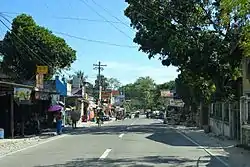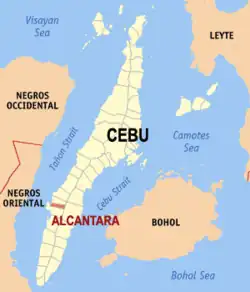Alcantara | |
|---|---|
| Municipality of Alcantara | |
 Alcantara, Cebu – National road | |
 Flag | |
 Map of Cebu with Alcantara highlighted | |
OpenStreetMap | |
.svg.png.webp) Alcantara Location within the Philippines | |
| Coordinates: 9°58′18″N 123°24′17″E / 9.971533°N 123.404678°E | |
| Country | Philippines |
| Region | Central Visayas |
| Province | Cebu |
| District | 7th district |
| Founded | 1830 |
| Named for | Alcántara, Spain |
| Barangays | 9 (see Barangays) |
| Government | |
| • Type | Sangguniang Bayan |
| • Mayor | Fritz A. Lastimoso |
| • Vice Mayor | Larry M. Llenos |
| • Representative | Peter John D. Calderon |
| • Municipal Council | Members |
| • Electorate | 11,853 voters (2022) |
| Area | |
| • Total | 35.20 km2 (13.59 sq mi) |
| Elevation | 47 m (154 ft) |
| Highest elevation | 297 m (974 ft) |
| Lowest elevation | 0 m (0 ft) |
| Population (2020 census)[3] | |
| • Total | 16,910 |
| • Density | 480/km2 (1,200/sq mi) |
| • Households | 4,384 |
| Economy | |
| • Income class | 5th municipal income class |
| • Poverty incidence | 22.30 |
| • Revenue | ₱ 81.32 million (2020) |
| • Assets | ₱ 238.4 million (2020) |
| • Expenditure | ₱ 83.19 million (2020) |
| • Liabilities | ₱ 36.22 million (2020) |
| Service provider | |
| • Electricity | Cebu 1 Electric Cooperative (CEBECO 1) |
| Time zone | UTC+8 (PST) |
| ZIP code | 6033 |
| PSGC | |
| IDD : area code | +63 (0)32 |
| Native languages | Cebuano Tagalog |
Alcantara, officially the Municipality of Alcantara (Cebuano: Lungsod sa Alcantara; Tagalog: Bayan ng Alcantara), is a 5th class municipality in the province of Cebu, Philippines. According to the 2020 census, it has a population of 16,910 people.[3]
Alcantara is one of the eight municipalities comprising the 7th Congressional District Cebu Province. It is 95 kilometres (59 mi) from Cebu City.
Geography
Alcantara is bordered to the north by the town of Ronda, to the west is the Tañon Strait, to the east is the town of Argao, and to the south is the town of Moalboal.
Barangays
Alcantara is politically subdivided into 9 barangays. Each barangay consists of puroks and some have sitios.
|
||||||||||||||||||||||||||||||||||||||||||||||||||||||||||||||||||||||||||||||||||||
Climate
| Climate data for Alcantara, Cebu | |||||||||||||
|---|---|---|---|---|---|---|---|---|---|---|---|---|---|
| Month | Jan | Feb | Mar | Apr | May | Jun | Jul | Aug | Sep | Oct | Nov | Dec | Year |
| Mean daily maximum °C (°F) | 29 (84) |
30 (86) |
31 (88) |
32 (90) |
31 (88) |
30 (86) |
30 (86) |
30 (86) |
30 (86) |
29 (84) |
29 (84) |
29 (84) |
30 (86) |
| Mean daily minimum °C (°F) | 23 (73) |
22 (72) |
23 (73) |
24 (75) |
25 (77) |
25 (77) |
24 (75) |
24 (75) |
24 (75) |
24 (75) |
24 (75) |
23 (73) |
24 (75) |
| Average precipitation mm (inches) | 42 (1.7) |
34 (1.3) |
40 (1.6) |
61 (2.4) |
124 (4.9) |
188 (7.4) |
190 (7.5) |
191 (7.5) |
189 (7.4) |
186 (7.3) |
124 (4.9) |
73 (2.9) |
1,442 (56.8) |
| Average rainy days | 10.0 | 8.5 | 9.5 | 12.8 | 22.3 | 26.8 | 28.4 | 27.9 | 27.3 | 27.6 | 20.5 | 13.1 | 234.7 |
| Source: Meteoblue[6] | |||||||||||||
Demographics

| Year | Pop. | ±% p.a. |
|---|---|---|
| 1903 | 4,698 | — |
| 1918 | 5,958 | +1.60% |
| 1939 | 5,754 | −0.17% |
| 1948 | 5,771 | +0.03% |
| 1960 | 5,625 | −0.21% |
| 1970 | 6,866 | +2.01% |
| 1975 | 7,752 | +2.46% |
| 1980 | 7,882 | +0.33% |
| 1990 | 9,559 | +1.95% |
| 1995 | 10,224 | +1.27% |
| 2000 | 11,532 | +2.61% |
| 2007 | 13,036 | +1.71% |
| 2010 | 13,556 | +1.43% |
| 2015 | 15,160 | +2.15% |
| 2020 | 16,910 | +2.17% |
| Source: Philippine Statistics Authority[7][5][8] | ||
Economy
Education
The public schools in the town of Alcantara are administered by one school district under the Schools Division of Cebu Province.
Elementary schools:
- Alcantara Central Elementary School — Poblacion
- Cabil-isan Elementary School — Cabil-isan
- Candabong Elementary School — Candabong
- Lawaan Elementary School — Lawaan
- Manga Elementary School — Manga
- Palanas Elementary School — Palanas
- Polo Elementary School — Polo
- Salagmaya Elementary School — Salagmaya
High schools:
- Alcantara National High School — Poblacion
Integrated schools:
- Cabadiangan Integrated School — Cabadiangan
Private schools:
- Saint Augustine Academy, Inc. — Poblacion
References
- ↑ Municipality of Alcantara | (DILG)
- ↑ "2015 Census of Population, Report No. 3 – Population, Land Area, and Population Density" (PDF). Philippine Statistics Authority. Quezon City, Philippines. August 2016. ISSN 0117-1453. Archived (PDF) from the original on May 25, 2021. Retrieved July 16, 2021.
- 1 2 3 Census of Population (2020). "Region VII (Central Visayas)". Total Population by Province, City, Municipality and Barangay. Philippine Statistics Authority. Retrieved 8 July 2021.
- ↑ "PSA Releases the 2018 Municipal and City Level Poverty Estimates". Philippine Statistics Authority. 15 December 2021. Retrieved 22 January 2022.
- 1 2 Census of Population and Housing (2010). "Region VII (Central Visayas)" (PDF). Total Population by Province, City, Municipality and Barangay. National Statistics Office. Retrieved 29 June 2016.
- ↑ "Alcantara: Average Temperatures and Rainfall". Meteoblue. Retrieved 9 May 2020.
- ↑ Census of Population (2015). "Region VII (Central Visayas)". Total Population by Province, City, Municipality and Barangay. Philippine Statistics Authority. Retrieved 20 June 2016.
- ↑ Censuses of Population (1903–2007). "Region VII (Central Visayas)". Table 1. Population Enumerated in Various Censuses by Province/Highly Urbanized City: 1903 to 2007. National Statistics Office.
{{cite encyclopedia}}: CS1 maint: numeric names: authors list (link) - ↑ "Poverty incidence (PI):". Philippine Statistics Authority. Retrieved December 28, 2020.
- ↑ "Estimation of Local Poverty in the Philippines" (PDF). Philippine Statistics Authority. 29 November 2005.
- ↑ "2003 City and Municipal Level Poverty Estimates" (PDF). Philippine Statistics Authority. 23 March 2009.
- ↑ "City and Municipal Level Poverty Estimates; 2006 and 2009" (PDF). Philippine Statistics Authority. 3 August 2012.
- ↑ "2012 Municipal and City Level Poverty Estimates" (PDF). Philippine Statistics Authority. 31 May 2016.
- ↑ "Municipal and City Level Small Area Poverty Estimates; 2009, 2012 and 2015". Philippine Statistics Authority. 10 July 2019.
- ↑ "PSA Releases the 2018 Municipal and City Level Poverty Estimates". Philippine Statistics Authority. 15 December 2021. Retrieved 22 January 2022.
External links
